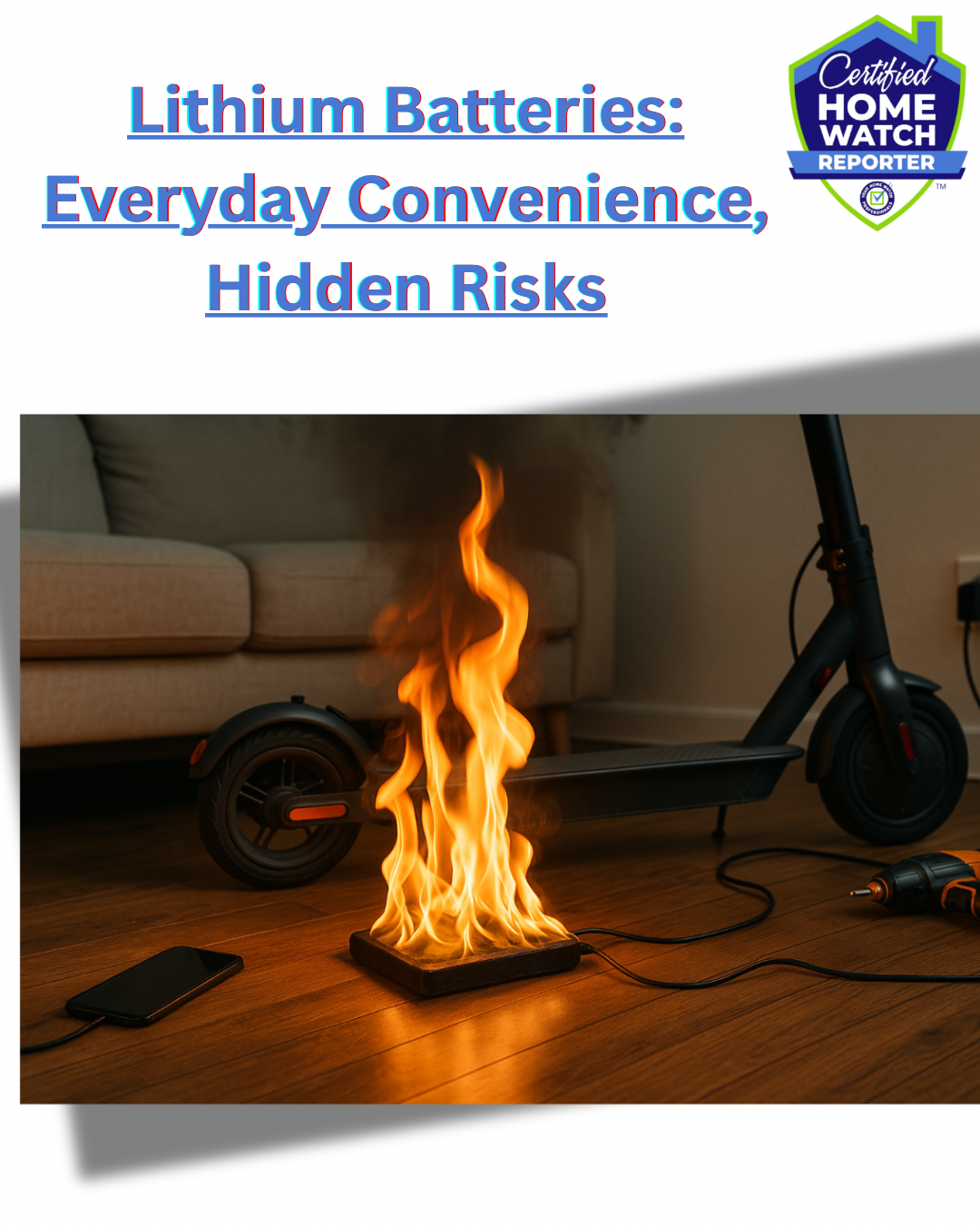Lithium Battery Fires at Home: Risks and Prevention
October 1, 2025
Diane Pisani
Lithium-ion batteries power our phones, laptops, e-bikes, and more – but if mishandled, they can pose a serious fire hazard. In fact, lithium batteries have caused hundreds of home fires in recent years, with at least 29 deaths linked to these fires in New York City alone. These fires burn extremely hot and spread fast, producing toxic smoke and even reigniting after being doused. Understanding the risks and taking precautions can protect your home and family.

Common Causes of Lithium Battery Fires in Homes
Most lithium battery fires result from preventable issues. Common causes include overcharging or leaving batteries on the charger for too long, using damaged or low-quality batteries, and leaving devices unattended while charging.
Such practices put stress on the battery and can trigger overheating or “thermal runaway,” where the battery chemistry uncontrollably ignites.
Physical damage or manufacturing defects in a battery (often seen in cheap, off-brand products) can also lead to fires, especially if the battery is improperly charged or handled. For example, using the wrong charger or a counterfeit battery pack can be dangerous – one house fire in Queens was traced to an incompatible charger used for an e-bike’s lithium battery.
Alarming Statistics and Recent Incidents
This is not a hypothetical threat – lithium battery fires are on the rise. New York City firefighters responded to 268 lithium battery fires in 2023 alone.
, many sparked by e-bike or scooter batteries charging indoors. Overall, NYC has seen a sharp increase in these fires, resulting in dozens of injuries and fatalities.
. Unfortunately, the trend extends beyond New York. In London, the fire brigade dealt with 183 lithium battery fires in 2023, a number that jumped to 467 fires in 2024 – with e-bikes and e-scooters as the leading culprits.
. Nationwide in the U.S., more than 25,000 battery incidents (fires or severe overheating) were reported over a recent five-year period.
. These incidents have destroyed homes, apartments, and even taken lives, underscoring the need for vigilance. Lithium battery fires can be especially difficult to extinguish, as the batteries can emit oxygen and reignite even after initial suppression.
Safety Tips to Reduce the Risk at Home
An electric scooter charging indoors. Devices like e-bikes should be charged safely and never left unattended, as their lithium batteries can pose fire risks if.
To protect your home and loved ones, follow these battery safety tips:
Use Certified Devices and Chargers: Only purchase devices and batteries that have been tested by a recognized safety lab (look for the UL certification mark). Always use the manufacturer’s recommended charger and power adapter for your device.
. Cheap aftermarket chargers or knock-off batteries may lack safety features and have been linked to fires.
Follow Proper Charging Practices: Charge batteries on a hard, flat surface (like a floor or sturdy table) away from anything flammable. Never charge devices on a bed, couch, under a pillow, or near curtains.
. Do not leave batteries charging overnight or unattended – unplug them once fully charged to prevent overcharging
. Avoid charging multiple devices on the same outlet or power strip to prevent electrical overload.
Avoid Extreme Temperatures: Store and use lithium-powered devices at room temperature whenever possible. Don’t charge or leave batteries in places that get very hot or freezing cold (for example, in direct sunlight, inside a parked car on a hot day, or outdoors in subzero weather)
. Extreme heat or cold can damage the battery and increase fire risk.
Watch for Damage or Warning Signs: Regularly inspect your devices and batteries. If you notice a battery is swollen, cracked, leaking, has an odd odor, or is making hissing/crackling noises – this is a serious warning sign.
Stop using it immediately. If safe to do so, move the device away from anything flammable. Do not continue charging or using a damaged battery. If the battery catches fire or begins smoking, evacuate the area and call 911 right away.
Safe Storage and Placement: When charging, place devices away from combustible materials and never block exit paths. For example, don’t charge e-bikes or scooters near your door or in hallways – you need a clear escape route in case of fire.
If possible, charge larger devices (like electric scooters) outside or in a well-ventilated area away from living spaces.
Always keep batteries and chargers away from anything that can easily burn (papers, fabrics, rugs).
Proper Disposal: Old or damaged lithium batteries should never go in the regular trash. These batteries can ignite in garbage trucks or landfills. Instead, take them to a battery recycling drop-off or hazardous waste center. Many communities and stores have free battery recycling programs. Before recycling, tape over the battery terminals or put the battery in a plastic bag to prevent short-circuits
Stay Informed and Prepared: Keep up with product recalls – if a device or battery has a known defect, stop using it and contact the manufacturer. Ensure your home has working smoke alarms on every level and an emergency escape plan.
A smoke detector can alert you early if a battery overheats at night. In case a lithium battery fire does occur, focus on getting everyone out safely and call the fire department. Do not attempt to fight a large lithium battery fire on your own, as special techniques or extinguishers may be required
Prevention is key – with the above precautions, the chances of a lithium battery fire in your home drop dramatically. These batteries are part of our daily life, but by handling them responsibly, you can enjoy their benefits safely. Stay informed, stay safe, and spread the word about lithium battery fire safety to family and neighbors. Together, we can keep our homes fire-free and enjoy our devices with peace of mind.
#HomeSafety #FireSafety #BatterySafety #LithiumIon #FirePrevention #HomeWatchAcademy








